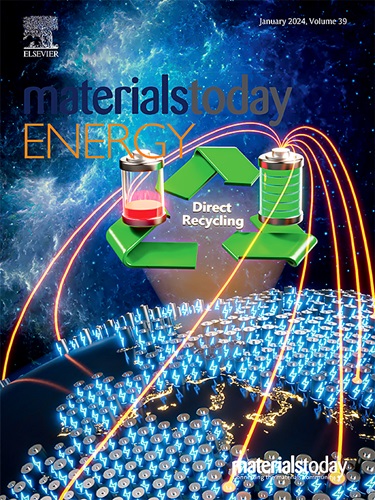褐煤衍生纳米碳作为 DSSC 的表面钝化剂和共敏化剂
IF 8.6
2区 材料科学
Q1 CHEMISTRY, PHYSICAL
引用次数: 0
摘要
界面激子重组和吸收区域狭窄是限制 DSSC 性能的两个瓶颈。本研究的重点是利用褐煤衍生的纳米碳作为表面钝化剂和共敏化剂来提高太阳能电池的效率。纳米碳的加入增强了 N719 染料的光谱吸收区域,并产生了浴色偏移,起到了共敏化剂的作用。此外,淬灭聚光光谱显示,纳米碳还通过减少激子重组和充当表面钝化剂,帮助电子迅速转移到氧化钛的传导带。在强度为 100 mWcm 的 AM 1.5G 辐照下测量所制造的 DSSC 时,纳米碳基器件的效率(ŋ)为 9.02%,光电流密度为 20.45 mAcm,优于原始器件(ŋ = 6.21%)。PCE 提高了 45%。因此,研究结果表明,从造成污染的燃料中提取的纳米碳可协同提高 DSSC 的性能。本文章由计算机程序翻译,如有差异,请以英文原文为准。
Lignite derived nanocarbon as surface passivator and co-sensitizer in DSSC
Interfacial exciton recombination and narrow absorption region are two bottlenecks that limit the performance of a DSSC. The present study focuses on improving the solar cell’s efficiency by utilizing a lignite-derived nanocarbon that behaves as a surface passivator and co-sensitizer. Incorporating nanocarbon enhanced the spectral absorption region of N719 dye with a bathochromic shift and played the role of a co-sensitizer. In addition, the quenched PL spectra revealed that nanocarbon also aids in the swift transfer of electrons to the conduction band of TiO by reducing the exciton recombination and acting as a surface passivator. On measuring the fabricated DSSC under AM 1.5G irradiation with the intensity of 100 mWcm, the nanocarbon-based device exhibited an efficiency (ŋ) of 9.02% with a photocurrent density of 20.45 mAcm, outperforming the pristine device (ŋ = 6.21%). An enhancement of 45% in the PCE was achieved. Thus, the results unveiled that nanocarbons derived from pollution-causing fuel synergistically aided in enhancing the performance of DSSC.
求助全文
通过发布文献求助,成功后即可免费获取论文全文。
去求助
来源期刊

Materials Today Energy
Materials Science-Materials Science (miscellaneous)
CiteScore
15.10
自引率
7.50%
发文量
291
审稿时长
15 days
期刊介绍:
Materials Today Energy is a multi-disciplinary, rapid-publication journal focused on all aspects of materials for energy.
Materials Today Energy provides a forum for the discussion of high quality research that is helping define the inclusive, growing field of energy materials.
Part of the Materials Today family, Materials Today Energy offers authors rigorous peer review, rapid decisions, and high visibility. The editors welcome comprehensive articles, short communications and reviews on both theoretical and experimental work in relation to energy harvesting, conversion, storage and distribution, on topics including but not limited to:
-Solar energy conversion
-Hydrogen generation
-Photocatalysis
-Thermoelectric materials and devices
-Materials for nuclear energy applications
-Materials for Energy Storage
-Environment protection
-Sustainable and green materials
 求助内容:
求助内容: 应助结果提醒方式:
应助结果提醒方式:


